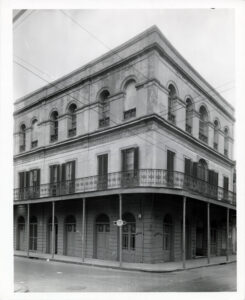Delphine Lalaurie
Delphine Macarty Lalaurie, of antebellum New Orleans, was notorious for the cruel treatment the people she enslaved.

Courtesy of Louisiana State Museum
Lalaurie House on Royal Street. Johnston, Frances Benjamin (Artist)
Delphine Macarty Lalaurie was a wealthy white New Orleans woman infamous for cruel treatment of her slaves. Rumors of her atrocities had been circulating for years, and on the morning of April 10, 1834, a fire at Madame Lalaurie’s Royal Street mansion revealed seven bondspeople who had been starved, tortured, and chained. As the day went on and the sheriff did not arrest the culprit, an increasingly angry crowd gathered around the Lalaurie home. Finally her carriage burst out of the gate and sped to Lake Pontchartrain, where she boarded a schooner. The mob, enraged by her escape, nearly demolished the empty house. The lurid nature of the actual events gave rise to subsequent rumors, urban legends, and folktales.
Madame Lalaurie, born Marie Delphine Macarty on March 19, 1787, was a member of the powerful Macarty clan, which included military officers, planters, merchants, and government officials. She was the daughter of the Chevalier Louis Barthélémy Macarty and his wife, Marie Jeanne Lerable. In 1800, at age fourteen, Lalaurie married Ramon López y Ángulo, newly arrived intendente of the Louisiana colony, a position second in command to the governor. Because López had contracted marriage without royal permission, he was relieved of his duties and sent into exile. He was eventually pardoned and given the position of Spanish consul to New Orleans. He died off the coast of Cuba on the return trip, and Lalaurie gave birth to their daughter in Havana in 1805.
Two years later, Lalaurie married Jean Blanque, a merchant, lawyer, banker, state legislator, and political intriguer, who was also a slave trader, smuggler, and associate of the pirates Jean and Pierre Laffite. Lalaurie had three daughters and a son with Blanque before he died, deeply in debt, in 1815. Lalaurie settled Blanque’s estate and skillfully managed the land and slaves inherited from her parents. As a result, she was a very wealthy woman when she met her third husband, Dr. Louis Lalaurie, in 1825. Lalaurie was sixteen years younger than Delphine, newly arrived in New Orleans after graduating from medical school in France. A son was born five months before their marriage in 1828. The couple proved to be incompatible and lived apart much of the time.
Lalaurie, her husband, and other family members fled New Orleans after the 1834 fire, traveling from Mobile to New York and then to France. They first took refuge at Lalaurie’s family home in Villeneuve-sur-Lot, but by 1835 they had settled in Paris. Within a few years Louis Lalaurie left for Havana and was never reunited with his wife and son. Delphine lived the rest of her life in Paris. She died on December 7, 1849, and was interred in the Cimetière de Montmartre. Her body was exhumed in 1851 for reinterment in St. Louis Cemetery No. 1 in New Orleans.
